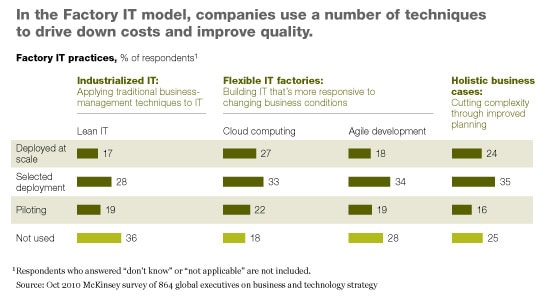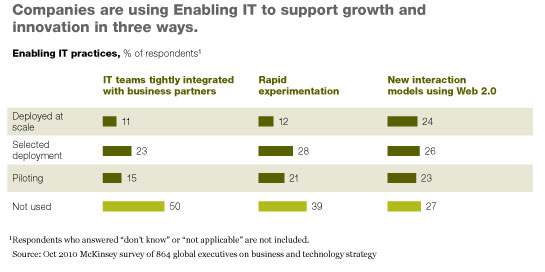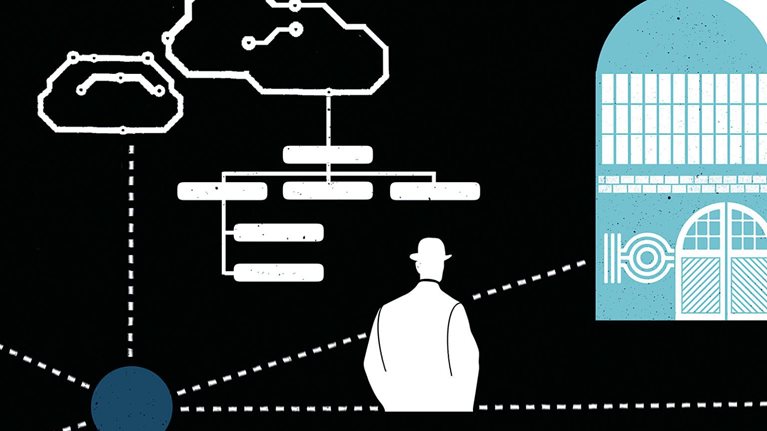Despite decades of increasingly intensive use of information across industries, IT has remained a black box for many executives. Too often, the link between spending and performance has been unclear, if not problematic. As a result, leaders felt that their only course of action was to hire a competent CIO, throw increasing amounts of money at IT, and hope for the best. The economic disruptions of recent years, however, have tightened budgets and placed a premium on action, forcing companies to rethink IT’s fundamental role.
In most organizations, IT began as a support function, leading to a one-dimensional management approach. However, technology-enabled products, interactive communications, and an “always on” information environment have thrust IT to the forefront, with critical implications for business growth and customer engagement. In addition, established practices, such as lean-management techniques, have highlighted the value of IT in reducing waste and increasing productivity.
This deeper recognition of IT’s potential has given rise to a new management model consisting of two categories: “Factory IT” and “Enabling IT.” Factory IT encompasses the bulk of an organization’s IT activities, applying lessons from the production floor—scale, standardization, and simplification—to drive efficiency, optimize delivery, and lower unit costs. Enabling IT is focused on helping organizations respond more effectively to changing business needs and gain a competitive advantage by spurring innovation and growth.
This approach goes beyond simply relabeling functions to include broader leadership, governance, and organizational changes, and IT leaders will need very different skills to manage each model. Business leaders will have to engage with IT in new ways. For instance, while IT standardization and consolidation increase responsiveness, speed to market, and cost effectiveness, managers may have fewer options to customize solutions. Likewise, more transparency and better metrics may come at the expense of unrestricted choice for configuration and architecture. In return, business leaders would get a new type of IT partner to support innovation, with skills to deliver IT-enabled capabilities quickly that drive both top- and bottom-line growth. But they’ll need to treat such IT staff as full members of their group, offering incentives and rewards for exceptional performance.
Factory IT: More efficient IT services
The core elements of the typical IT function have changed radically over the past decade, and this evolution has enabled the Factory model. Ten years ago, a company might have felt compelled to create its own software to manage the supply chain and other activities; today, many configurable products can meet those needs. Similarly, expensive, single-purpose servers and the dedicated support staff they require can be replaced by commodity servers, often managed from half a world away.
Moreover, these standardized platforms can now be coupled with mature processes for managing broad swaths of IT, including basic infrastructure and many of the business applications. Under this configuration, IT activities can be restructured and continually improved much as any other business process, using a combination of lean techniques, automation, and outsourcing or cloud computing to drive down costs and improve quality. Results from our latest technology survey1 demonstrate how companies have already begun to implement some of these practices (Exhibit 1).

There are three key components of the Factory model:
Industrialized IT—applying traditional business-management techniques to IT
Standardization decreases the resources and specialized development needed to support IT, allowing organizations to apply proven management methods from large industrial settings to reduce IT costs. Lean-management techniques have evolved well beyond manufacturing and are applicable to the types of skilled services found in IT. A company can typically create 20 to 30 percent or more in additional IT capacity by streamlining processes, automating routine functions, and eliminating redundancy. Major sources of IT waste include unnecessary functionality (for example, gold-plated systems with extra, noncore functions), work flow bottlenecks caused by inadequate cross-training, and frequent rework from bugs or constantly changing requirements.
Companies can benefit significantly by replacing customized systems with highly standardized offerings (for example, a Web server or e-mail platform that includes common hardware, applications, and support levels) and service catalogs (essentially à la carte menus that specify the cost of each service). These improvements increase cost transparency and highlight clear opportunities for further efficiency while also giving individual business units the freedom to customize certain features and functions.
Organizations should also recognize that not all processes have equal value and should set service and support levels accordingly. For instance, one bank applied the same exacting levels of support and performance for its critical core banking applications to an in-house employee service portal. By increasing the service portal’s allowable downtime to five days a year, from just five hours, the bank saved hundreds of thousands of dollars in hardware, software, and staff expense.
In our experience, these measures often double workforce productivity by redeploying or reducing staff. A standardized IT environment also allows companies to select from a wider array of vendors whose scale and skills can further reduce costs and improve delivery. In addition, by avoiding customized hardware and operating systems, companies can more readily take advantage of a technology cost curve that has been dropping by 4 to 5 percent annually.
Flexible IT factories—building IT that’s more responsive to changing business conditions
IT tends to operate on a very long-term investment cycle consisting of large, multiyear projects, extended outsourcing deals, and durable infrastructure assets. As the pace of business change accelerates and organizations respond to shifting market conditions or more frequent M&A, IT leaders are often constrained by these investments. IT departments are starting to adapt in two ways:
The cloud: Cloud computing offers access to information, processing, and storage through the network or an external service provider. This mode of delivery allows companies to purchase computer processing as a service, rather than making up-front investments in IT capacity and in-house support staff. The New York Times, for example, digitized and catalogued more than 100 years of archived articles for its Web site in a 24-hour period by using Amazon.com’s cloud offering, avoiding the need to configure and operate a set of servers for a onetime effort.
Agile software development. IT programmers are flocking to approaches that emphasize the very fast, iterative development of systems through close interactions with users, allowing continual feedback and programming refinement. This agility can deliver new systems and capabilities in a matter of weeks or months instead of years. A frequent iteration cycle also keeps IT developers and business users in sync on requirements and priorities. Agile development may not be right for every project. However, since this approach is most effective when business needs are shifting, it is gaining favor among many IT departments.
Together, the cloud and agility can make the IT factory more nimble, with lower costs and faster delivery.
Holistic business cases—cutting complexity through improved planning
For most companies, IT complexity increases gradually, as systems slowly evolve beyond their initial purpose, or through acquisitions, when new, sometimes duplicative systems are built for individual business units. Performance suffers over time, as ineffective IT slows product introductions, hampers customer interactions, and often makes postmerger integration more difficult.
IT leaders recognize the adverse effects of complexity, but replacing these systems involves a substantial commitment of resources: hardware, new applications, and staff and vendor time. The economics are difficult to justify given the short time horizons of many tough-minded CFOs, particularly since tangible benefits are often realized only in the longer term.
To manage complexity, companies are starting to employ a more holistic business case model that goes beyond the traditional, IT-centric versions. This model includes realistic, verifiable cost–benefit analysis to assess the impact of new systems on the entire organization. Critically, such plans also require a road map for how future projects might build on the investment. At one company, for instance, the business case to deliver a unified view of all customer data showed how better information management could enable follow-on projects for marketing systems, enhancing cross-selling opportunities.
The benefits of these business cases are twofold. First, they ensure that the simplification of processes and systems is a starting point for new project investments. Second, better visibility can show how seemingly small IT projects can deliver a high return on investment by improving standardization and service levels across the entire business (see sidebar “Implementing Factory IT”).
Enabling IT: Supporting innovation and delivering business value
As the market-facing complement to the Factory model, Enabling IT focuses on creating new sources of value. This emphasis on innovation requires three things: ready access to relevant information, a willingness to test and learn, and close collaboration. Enabling IT supports these activities by developing the processes and technologies to launch a new sales channel, design a tech-enabled product feature, or increase customer retention through online offerings.
Where Factory IT is housed centrally, Enabling IT’s employees function as an IT SWAT team for new initiatives or business imperatives and are often closely integrated with—or even embedded in—business units. The performance of these employees is rated on metrics such as responsiveness and flexibility rather than on their ability to deliver low unit costs. And where Factory IT focuses on long-term projects and on-time delivery, Enabling IT is typified by rapid prototyping and iterative development. Our survey results show that companies deploy Enabling IT to support innovation and growth in three ways (Exhibit 2):

Turning raw data into insight
The increasing volume of data is taxing the ability of companies to track, filter, and analyze information and turn it into useful, actionable insights. Organizations that build effective information systems can take advantage of emerging opportunities and respond more quickly to unseen market changes. With the rise of electronic health records and prescription data, for example, pharmaceutical companies need systems to structure and mine this information for trends on patient compliance or drug efficacy.
Resolving these issues requires a cross-functional group of IT experts, statistical analysts, and business leaders. IT must develop new technical capabilities to manage the massive amount of information, and IT leaders will need to collaborate more closely with management teams to extract its full value.
Supporting rapid experimentation
Where lean manufacturing and Factory IT seek to avoid errors, Enabling IT’s mind-set tolerates (and even encourages) the mistakes that result from experimentation and iteration as long as they happen quickly, the outcomes are measured, and the lessons are incorporated into the team’s thinking. More companies are embracing rapid experimentation as a way to develop, refine, and upgrade their services or products. Capital One and Google, for example, have been at the forefront of this trend with their credit cards and online services, respectively. That wave is spreading to traditional players: P&G’s Vocalpoint, a network of mothers, provides feedback on new product ideas. Similarly, a leading fast-food company is using IT systems and analytics at test sites to gauge the impact of new menu choices on store-level revenue, operations, and customer experience.
Such experimentation requires the right set of technical capabilities and a flexible IT environment. Managers must employ tools to define, build, test, and improve new products quickly, integrating feedback from both internal stakeholders and a set of users or customers. Responsive IT support is a vital component of this effort. By assembling a team to work hand in hand with the managers on these new business offerings, IT provides essential support to help build and modify business processes and systems rapidly.
Web 2.0—fostering new interaction models
IT has historically focused on automating high-velocity transactions for enterprise resource planning (ERP), supply chains, and customer relationship management (CRM). That focus is now shifting to lightweight Web 2.0 tools2 to support the more diverse transactions and more complex interactions that shape, review, and inform innovation.3 Tools range in complexity from simple executive blogs to more robust portals where users can collaboratively access and analyze data sets.
Often, these newer forms of knowledge sharing require little additional investment, since the content is largely user generated and the tools rely mostly on existing applications and infrastructure. In fact, these tools usually augment existing transactional systems rather than replace them, thus increasing the value of IT investments while holding down costs. Since users often drive the development of these collaborative tools, strategies that complement users’ work practices and styles are most effective. Although such an endeavor is challenging, the payoff can be substantial.
Innovation is seldom neat, and these collaborative systems are no exception. Successful initiatives usually start as small side projects or tests that gain critical mass rapidly, often with little regard for corporate technology or security standards. IT leaders can play a critical role by selecting and validating platforms, setting policies, and promoting capabilities to potential participants. Because Enabling IT staff members already work within business units, they can help guide these projects, giving executives some degree of control and assurance on compliance with critical security and data standards. The result is a smoother transition to the Factory IT environment when the systems reach maturity (see sidebar “Enabling IT: Bringing it together”).
While leading companies may implement these principles differently based on their business needs and culture, we believe there is no turning back. Factory IT’s potential to increase efficiency and reduce costs can finance the next wave of Enabling IT’s innovation. The combination of functional productivity and business value creation will likely be a major competitive differentiator; the first step in delivering this value is to ensure companies have the right leaders in place for each effort.

